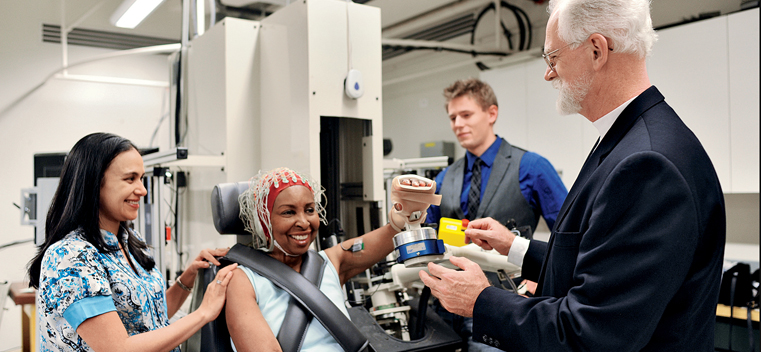
Robotic Rehabilitation
Tell us what you think. E-mail comments or questions to the editors at letters@northwestern.edu.
Ever wonder about those strange designations we use throughout Northwestern to identify alumni of the various schools of the University? See the complete list.
Find Us on Social Media
Healing machines help stroke victims regain functionality.
When mechanical engineering professor and U.S. National Academy of Sciences member Ted Belytschko was recovering from a stroke last year, his physical therapist suggested that a robot assist him on his treadmill rehab exercises.
It turns out that the robot, KineAssist, was developed just down the hall from his Technological Institute office by colleagues Michael Peshkin and Edward Colgate.
During his rehab sessions, Belytschko used the KineAssist to relearn how to walk. On the treadmill, “you feel like you’re going to fall every second, but it catches you,” said Belytschko, who has returned to teaching — and walking — thanks to the KineAssist.
Such devices are the wave of the future for rehab, said Julius Dewald, chair of physical therapy and human movement sciences at the Feinberg School of Medicine. “With these robotic devices we can create fantastic environments for people to learn to move in,” he said.
Dewald, who is also a professor of biomedical engineering, is also developing robotic devices to understand impairment and explore how movement in the upper limbs can be controlled differently after a stroke or other brain injury.
A stroke victim often loses the ability to control one joint at a time on the side of the body affected by the stroke. The person can move the limb, but doing so requires some help from the nonaffected hemisphere of the brain, resulting in limited control.
“When they lift up their arm and drive their shoulder muscles, they also drive their elbow, wrist and finger flexors at the same time,” Dewald said. “Many of our stroke victims over time get very frustrated, particularly the more moderately to severely impaired individuals who may be able to get around, but the arm is basically a useless appendage.”
Using robots to make a limb weightless, “like you’re in space,” and reducing the number of brain pathways required to move the shoulder, the stroke victim can slowly regain the ability to use individual joints. “They can reach almost as well as you and I do,” Dewald said.
By incrementally increasing the weight of the arm over a period of weeks, even people with moderate to severe impairment, including many who suffered strokes as many as 15 years ago, begin to regain some function and coordination.
Dewald and colleagues recently completed a study and will soon launch a second pilot project, adding resistance to the movement therapy to see if strengthening adds any benefit.
“These projects will allow us to rehabilitate the remaining control that may still be there from the affected hemisphere in totally new ways,” Dewald said.



 Facebook
Facebook Twitter
Twitter Email
Email


